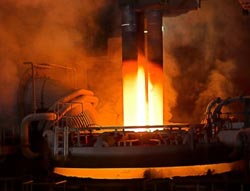An “Eye” that Measures Liquid Steel Temperatures

That’s why Siemens has developed a system called Simetal RCB Temp, which consists of an optical sensor that can determine the temperature of the molten metal in the steel production process (over 1,500 degrees Celsius) at shorter intervals than was previously the case. As a result, the best time to tap can be determined more exactly, thus saving time and energy and increasing work safety.
To produce steel in electric arc furnaces, scrap metal is melted down in a process that requires the temperature of the molten metal to be exactly and reliably measured. RCB Temp makes optimum melting sequence times possible, resulting in lower energy consumption and operating costs. Previously, the temperature had to be measured with measurement cartridges through the open slag door, because optical measurement systems are too sensitive to heat and soiling to be installed inside the furnaces. Manual measurements are strenuous, hazardous, and limit the number of measurements that can be taken until the steel is tapped. Siemens Industry has now successfully integrated the RCB (Refining Combined Burner) system into a robust optical temperature sensor.
The RCB system consists of a burner for melting the scrap metal and a lance for injecting a precisely concentrated stream of oxygen into the liquid steel. In order to measure the temperature, an inert gas is injected into the steel instead of oxygen. The gas stream enables the system to “look” into the molten metal like an eye, allowing the optical sensor at the rear of the lance to detect the liquid steel’s infrared radiation. The resulting data is used to calculate the temperature of the molten metal with the help of a special algorithm. The system doesn’t require measurement cartridges and can measure temperatures through a closed slag door and when heating power is on. And because the sensor is positioned at the rear of the lance, it is protected against damage when scrap iron is fed into the furnace.
Arc furnaces can easily be retrofitted with Simetal RCB Temp when they are shut down for maintenance. The system can increase productivity by up to two percent so that the investment is recouped in less than six months.
Media Contact
More Information:
http://www.siemens.com/innovationnewsAll latest news from the category: Power and Electrical Engineering
This topic covers issues related to energy generation, conversion, transportation and consumption and how the industry is addressing the challenge of energy efficiency in general.
innovations-report provides in-depth and informative reports and articles on subjects ranging from wind energy, fuel cell technology, solar energy, geothermal energy, petroleum, gas, nuclear engineering, alternative energy and energy efficiency to fusion, hydrogen and superconductor technologies.
Newest articles

A universal framework for spatial biology
SpatialData is a freely accessible tool to unify and integrate data from different omics technologies accounting for spatial information, which can provide holistic insights into health and disease. Biological processes…

How complex biological processes arise
A $20 million grant from the U.S. National Science Foundation (NSF) will support the establishment and operation of the National Synthesis Center for Emergence in the Molecular and Cellular Sciences (NCEMS) at…

Airborne single-photon lidar system achieves high-resolution 3D imaging
Compact, low-power system opens doors for photon-efficient drone and satellite-based environmental monitoring and mapping. Researchers have developed a compact and lightweight single-photon airborne lidar system that can acquire high-resolution 3D…





















